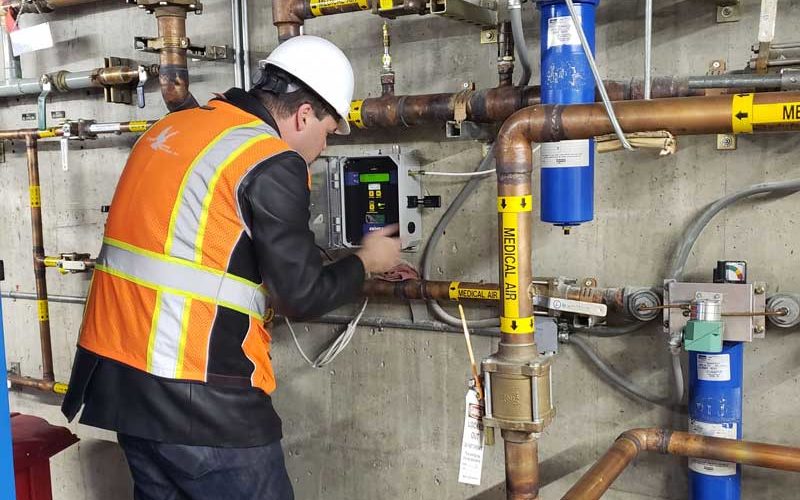What’s a Good Gas Detector Calibration Frequency?
Gas detectors only do their job when they are accurate. That accuracy depends on regular calibration. The right gas detector calibration frequency protects workers, keeps facilities compliant, and prevents costly shutdowns.
Many people ask how often calibration is needed. The answer depends on the type of device, the gases being monitored, and the environment where it is installed.
Typical Gas Detector Calibration Frequency: Device Type and Environment
Portable gas detectors usually require a bump test before each day of use. A full calibration is typically done once per month in demanding conditions. For units used less often, calibration can extend to three or even six months if bump tests are consistently passed.
Fixed gas detection systems in stable environments generally need calibration every three to six months. As a minimum guideline, annual service is required to keep records current and meet most compliance needs.
Facilities exposed to harsh conditions require more frequent attention. Semiconductor labs, aerospace sites, and plating operations often deal with corrosive gases or very low alarm thresholds. In these settings, calibration is needed every three months or even sooner to prevent drift from creating unsafe conditions.
Factors That Influence Calibration Frequency
How often you calibrate depends on how your detectors are used. A sensor that runs daily or is handled roughly will drift faster than one that is used only occasionally.
Gas type is another major factor. Reactive gases such as chlorine, fluorine, or ammonia put extra stress on electrochemical sensors. Some oxygen sensors built with lead-oxide also show faster than expected drift.
Environmental conditions also matter. High humidity, extreme temperature cycles, airborne dust, or heavy vibration can all shorten calibration intervals. Older sensors that already show drift are more likely to need closer monitoring and adjustment.
Real-World Costs of Calibration
At Hawk Equipment, portable gas detectors can be calibrated in our office for as little as $90 per unit. Fixed gas detection systems calibrated at a customer site usually cost between $80 and $120 per sensor, with a base site visit fee.
For smaller systems with just a few sensors, the mobilization cost is the main driver of expense. Adding more detectors to the same visit does not increase the cost much. Larger facilities with many devices often see substantial savings by planning calibrations through an annual service agreement.
What Are the Risks of Delaying Calibration?
Skipping calibration puts people, property, and compliance at risk. An uncalibrated detector may provide false readings, which could mean missing a dangerous leak or triggering a false alarm that disrupts operations.
Inspectors often require current calibration records before allowing a facility to maintain a certificate of occupancy. Failing an inspection can shut a building down for a day or longer. That lost time can cost hundreds of thousands of dollars, especially for manufacturers producing medical or defense-related products.
Old sensors are another problem. If a unit is pushed past its useful life, it may fail calibration altogether and remain out of service until replaced. A planned calibration by Hawk technicians would catch the issue early and avoid unnecessary downtime.
Compliance and Documentation
Auditors expect calibration records to be complete and accurate. Typical records include the calibration date, the date due, the technician name, sensor serial numbers, exact detector locations, and the calibration gas details with lot numbers.
Many customers find themselves scrambling for paperwork when an AHJ arrives. Hawk’s calibration process includes full documentation that prevents this issue. Our service records satisfy inspection requirements and help facilities avoid costly shutdowns.
Benefits of Routine Calibration Services
A scheduled maintenance contract takes the guesswork out of calibration. These agreements lock in service pricing, protect against labor cost increases, and allow work to be scheduled when it best fits facility operations.
Hawk technicians are cross-trained on all major brands and system types. Because we arrive with the correct supplies and knowledge, our customers are not paying for on-site learning. Calibration is completed correctly on the first visit.
Routine service also extends the life of your detectors. Regular attention catches drift before it becomes a problem and keeps every sensor ready to respond during an emergency.
Get Trusted Gas Detector Calibration Services Now
Choosing the right gas detector calibration frequency depends on your devices, your gases, and your environment. Missing or delaying calibration risks safety, compliance, and financial loss.
Contact Hawk Equipment today to schedule professional calibration services and keep your detectors working exactly as they should.

